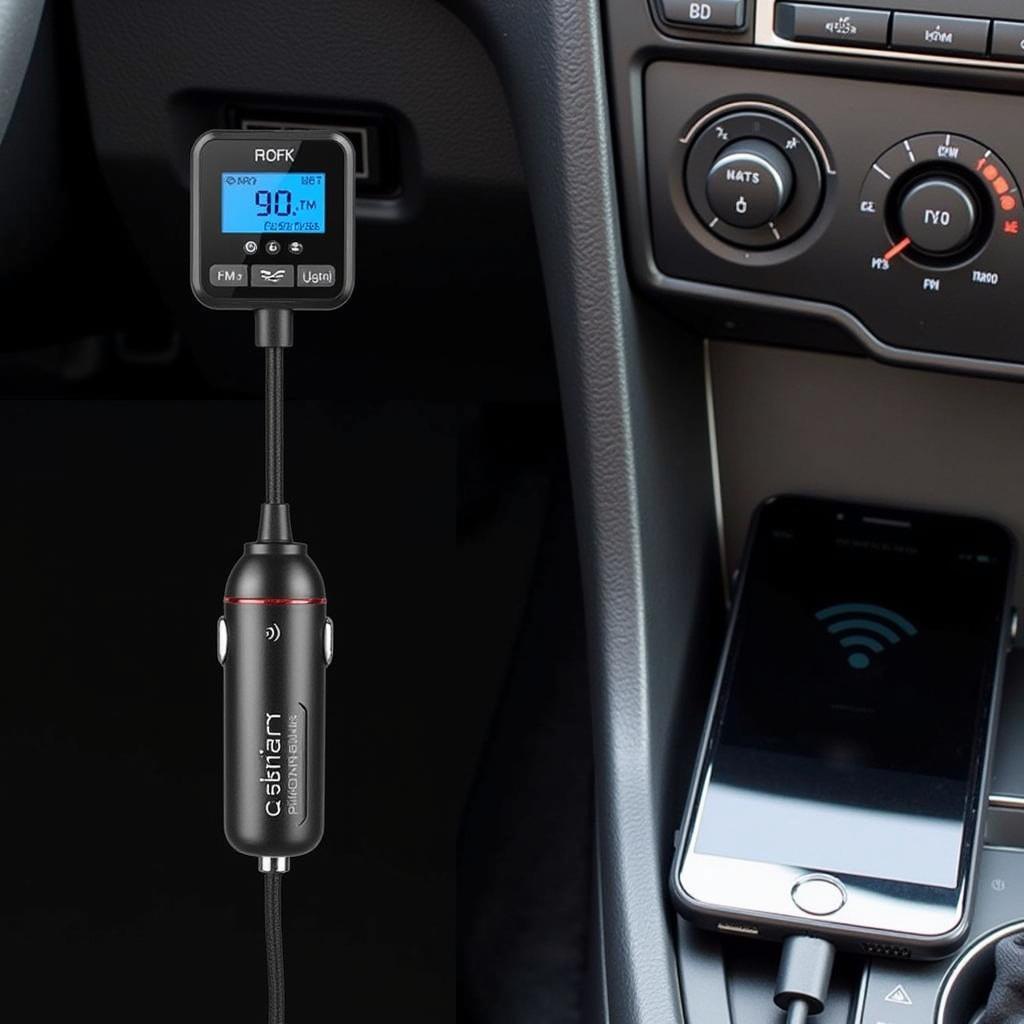Seeing a mini red brake warning light illuminated on your dashboard can be unsettling. It’s a clear signal that something needs your attention, but what exactly? This comprehensive guide is here to demystify the meaning behind this warning light and equip you with the knowledge to address it effectively.
Understanding Your Car’s Braking System
Before delving into the specifics of the red brake warning light, it’s helpful to grasp the basics of your car’s braking system. Essentially, it’s comprised of three main components:
- Hydraulic System: This network of components uses brake fluid to transmit force from the brake pedal to the wheels, slowing or stopping your vehicle.
- Mechanical Components: These include the brake pads, rotors (or drums), calipers, and other hardware that physically create the friction needed to stop your car.
- Electronic Systems: Modern vehicles often incorporate electronic components like Anti-lock Braking Systems (ABS) and Electronic Stability Control (ESC) to enhance braking performance and safety.
Common Causes of the Mini Red Brake Warning Light
The appearance of the mini red brake warning light usually indicates an issue within one or more of these braking system components. Let’s explore some of the most common culprits:
1. Low Brake Fluid Level
One of the most frequent reasons for the warning light to activate is a low brake fluid level. Brake fluid is the lifeblood of the hydraulic system, and a leak or depletion can significantly compromise your car’s ability to brake effectively.
2. Worn Brake Pads
Brake pads are designed to wear down over time as they generate friction against the rotors or drums. When the pads wear thin, their ability to create sufficient stopping power diminishes, triggering the warning light.
3. Faulty Brake Light Switch
The brake light switch is responsible for activating your brake lights when you press the brake pedal. If this switch malfunctions, it can disrupt the electrical signal that also controls the brake warning light, causing it to illuminate.
4. Issues with the ABS System
Modern cars equipped with Anti-lock Braking Systems (ABS) rely on sensors and an electronic control unit to prevent wheel lockup during braking. A malfunction within the ABS system, such as a faulty sensor, can trigger the warning light.
5. Parking Brake Engaged
While seemingly obvious, it’s surprisingly common for drivers to overlook the parking brake. If the parking brake is even slightly engaged, it can cause the warning light to illuminate.
What to Do When the Mini Red Brake Warning Light Comes On
If you notice the mini red brake warning light on your dashboard, it’s crucial to take immediate action:
- Safely Pull Over: Find a safe location to pull over to the side of the road and come to a complete stop.
- Check Your Parking Brake: Ensure that your parking brake is fully disengaged.
- Consult Your Owner’s Manual: Your vehicle’s owner’s manual will provide specific instructions and recommendations tailored to your car model.
- Check Brake Fluid Level: If you’re comfortable doing so, carefully check the brake fluid level in the reservoir. Caution: Brake fluid is corrosive, so wear gloves and eye protection. If the level is low, adding brake fluid might temporarily resolve the issue, but it’s crucial to have a mechanic diagnose the underlying cause.
- Seek Professional Assistance: If you’re unsure about any aspect of the warning light or if the problem persists, it’s best to err on the side of caution and seek professional help.
Diagnosing and Fixing the Problem: The Role of Remote Diagnostics
In today’s technologically advanced automotive landscape, remote diagnostics have emerged as a game-changer in troubleshooting and resolving car issues, including those related to the braking system.
2006 audi a4 brake warning light
Here’s how remote diagnostics work and their benefits:
- Connecting Your Car: Using a specialized device that plugs into your car’s OBD-II port, mechanics can remotely access your vehicle’s computer system.
- Retrieving Diagnostic Data: The device retrieves valuable data from your car’s sensors, including error codes related to the braking system.
- Expert Analysis: Skilled technicians analyze the data to pinpoint the root cause of the problem accurately.
- Remote Programming and Software Updates: In some cases, the issue can be resolved remotely by reprogramming or updating your car’s software.
Why Choose Remote Diagnostics and Software Solutions?
- Convenience: Get your car diagnosed and potentially fixed without leaving your home or office.
- Speed: Remote diagnostics often expedite the troubleshooting process, leading to quicker repairs.
- Accuracy: By analyzing precise data from your car’s computer, technicians can diagnose issues with a high degree of accuracy.
- Cost-Effectiveness: Remote diagnostics can save you time and money by reducing the need for multiple trips to the mechanic.
Prevention is Key: Maintaining Your Braking System
Regular maintenance is essential for keeping your car’s braking system in optimal condition and preventing potential issues:
- Routine Inspections: Have your brakes inspected by a qualified mechanic at least once a year or as recommended in your owner’s manual.
- Brake Fluid Flush: Brake fluid absorbs moisture over time, which can reduce its effectiveness. It’s recommended to flush and replace your brake fluid every 2-3 years or as specified by your car manufacturer.
- Timely Brake Pad Replacement: Replace your brake pads before they wear down too thin. Consult your owner’s manual or a mechanic for the recommended replacement interval.
- Address Warning Signs Promptly: Ignoring warning signs like a soft brake pedal, unusual noises, or vibrations can exacerbate problems and lead to more costly repairs.
Conclusion
renault master brake warning light
The appearance of the mini red brake warning light should never be ignored. It serves as a crucial indicator of potential issues within your car’s braking system, which is paramount for your safety on the road. By understanding the common causes, taking prompt action, and embracing the power of remote diagnostics and software solutions, you can address brake problems efficiently and ensure your vehicle remains safe and reliable.
Remember, regular maintenance is key to preventing brake issues and ensuring the longevity of your car’s braking system.
Expert Insight: “Don’t underestimate the importance of addressing brake warning lights promptly. Early detection and repair can prevent minor issues from escalating into major safety concerns.” – John Smith, Senior Automotive Technician.


